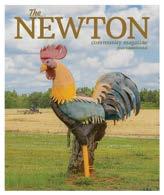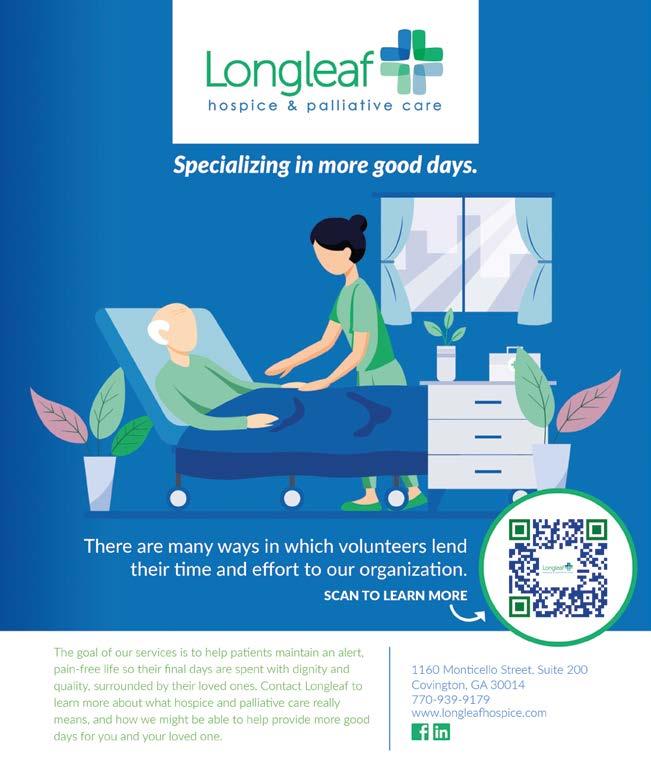
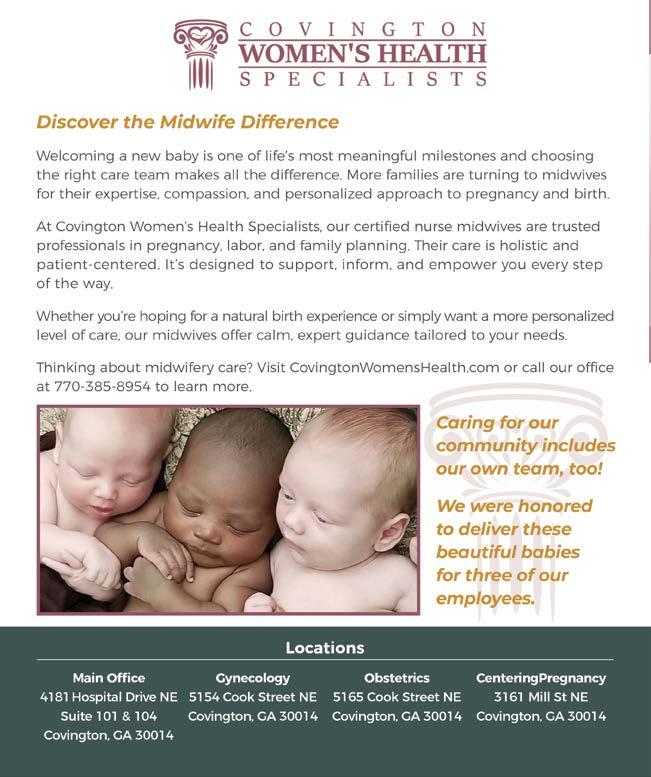







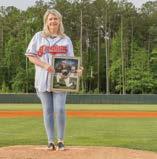
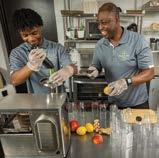
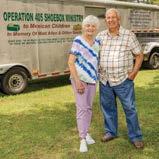













by BRIAN KNAPP
Live long enough and buildings become part of your story. For instance, the Franklin Store in Starrsville—which artist Tray Corley so brilliantly painted to serve as the latest cover of this magazine— has been an out-of-the-way landmark for decades. If you have lived in this community for any length of time, chances are you have driven past it at least once. Those less familiar with the area might have seen it in “Friday the 13th Part VI” or “In the Heat of the Night.” Imagine all the untold stories that structure alone holds.
Journeys around Newton County occasionally lead me to other places I know more intimately, past my childhood home on Old Monticello Street, up Cherry Valley Drive and into the neighborhood where I spent so much of my youth. Whether it was playing our version of wiffle ball in the cul-de-sac or honing our basketball skills on a cement court a friend’s dad had built behind his house on Elliott Street, we once roamed that stretch of asphalt like we owned it. Less than three decades later, physical evidence of our ever being there no longer exists. Even though most of us and our families have
long since moved away, it still looks much like it once did. Many of the houses with which we had grown so familiar are now occupied by other families who are hopefully building memories of their own. Perhaps Father Time will be as kind to them as he was to us.
I turned 47 in May, and I have come to the realization that I’m almost certainly over halfway done with my life. My oldest son just graduated high school, and my youngest will follow in two short years. Ferris Bueller was right when he said, “Life moves pretty fast. If you don’t stop and look around once in a while, you could miss it.” Whenever I feel the need to feel young again, I get behind the wheel, mosey on over to Cherry Valley Drive and let my old neighborhood speak to me for a few minutes.
Thank you Tray Corley for providing the art work for the 2025 summer cover. Tray’s work is on display at Southern Heartland Art Gallery in Covington as well as Van Gogh Art Gallery Madrid. Visit online at instagram.com/art_theperson and artsper.com.

I rode my bike 1,000 miles in two months, and most of those miles were logged on the Cricket Frog Trail. I saw a lot during my time pedaling away, including sasquatch. There were enormous benefits with this time in the saddle of my bike. Things like exercise, sunlight, social connection and being in nature, to name a few. However, the best of them was my time spent with God fighting the enemy.
If you know me well, then you know I wrestle with anxiety and depression, and one of my biggest triggers is being too far from home with no quick way to get back. When I first started riding, I would only go a couple of miles and turn back. The thought of being too far away was terrifying. Slowly, I was able to add distance each time I rode.
The enemy is constantly working to keep me tied down. To stay in my comfort zone. To never venture out into the unknown. To have no faith. But God was there with each crank of my pedals; and wow, we had a great time together. He was all around me in the deer, birds, rabbits, cows, swamps, the changing of the seasons, time with my son Wyatt and each breath that He allowed me to have.
I love how God takes the enemy’s tactics, which are intended to destroy me, and uses them instead to grow me. I want to finish the race He has for me to glorify Him. I will always remember those 1,000 miles and know I can do nothing without God.
Have a great day today.

Scott Tredeau



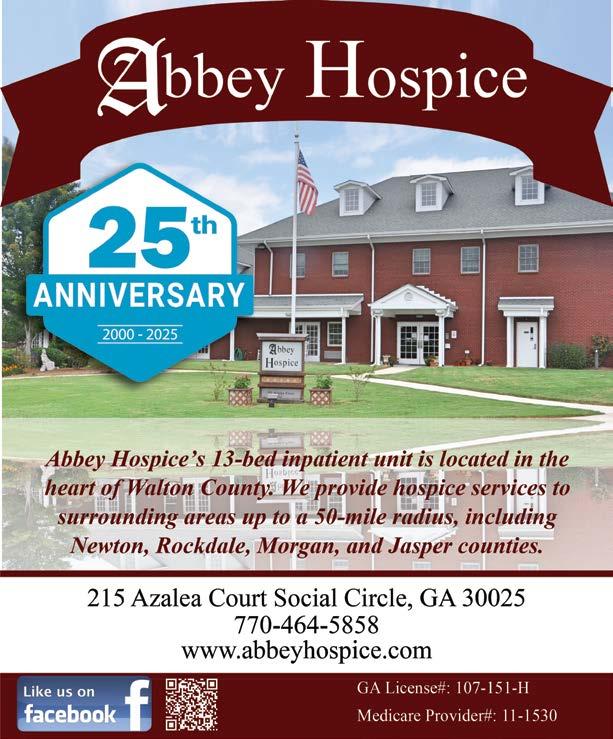
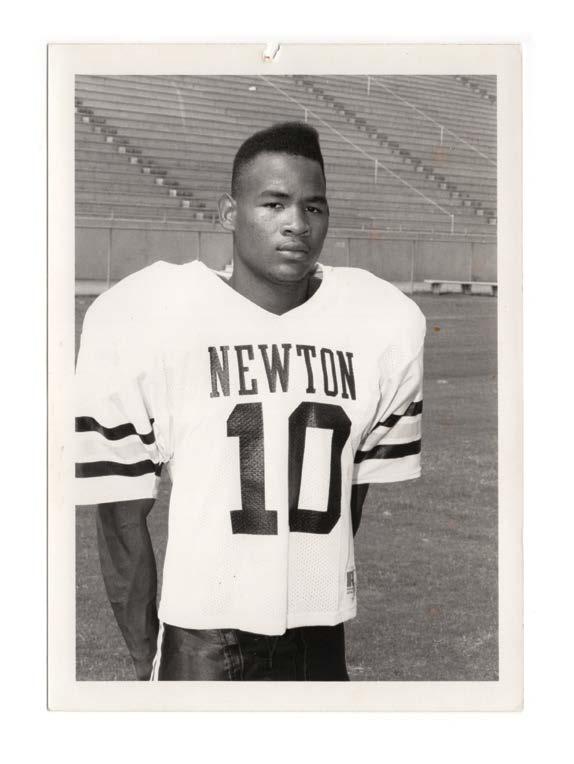
Gabriel Tuggle was once a multi-sport star with enough talent to perhaps one day choose between professional football or baseball, but a .44-caliber bullet to the head changed everything. Even so, he battled through a grim prognosis to rise again with another call to greatness.
by KARI APTED
Some athletes train for excellence, while others are born with natural prowess. Gabriel Tuggle had his feet in both groups. “When I picked up my first football at 2 years old, my mom saw how happy I was,” he said. “I carried that ball around with me every day, all the time.” Several outstanding basketball players on both sides of his family proved that some of his ability was owed to good genes. The rest came from hard work and dedication, as Tuggle grew up the youngest of four children in a single-parent family, determined to use his skills for good.
“My grandparents took all of us in,” he said. “Nine or 10 people lived in a two-bedroom house. My grandfather was the patriarch and worked several jobs. His main one was driving trucks. He also had a garden and a little farm that he took care of every morning before work. We didn’t have much, but I grew up in a house full of gratefulness and hard work. We appreciated what we had.”
Tuggle’s family could not afford to enroll him in youth sports, but that did not stop him from learning how to play football and baseball. “I’ve always picked up on stuff fast,” he said. “I would go watch my cousins’ and neighbors’ games and study how they swung the bat and hit the ball. Then I would practice until I became good at it.” Tuggle played touch football with older kids on his street, and the fact that they all wanted him on their team pushed him to elevate his game even faster.
“I would do my homework during breaks at school, so I could play sports with my friends as soon as I got home,” he said. “After we played football, we’d go play basketball, then a game of softball. I had my grandfather’s and my mom’s work ethic. Once I understood my strengths, I had one mission: to get my family out of our financial situation.”
By middle school, coaches were already noticing the young star. Tuggle added track to become a four-sport athlete in high school. He started on junior varsity but was invited to join varsity teams ahead of schedule. By 10th grade, he was receiving offers from colleges, and by his junior year, he had narrowed his focus to just football and baseball.
“I was going to be the next multiple-sport athlete coming up,” he said. “I was a top [Division I] prospect. I could’ve gone to college with dual-scholarship offers.” Tuggle’s friends often failed to understand his intense focus. “The guys were like, ‘Man, you live, eat [and] breathe sports. Come and take some time to have fun.’ But I was having fun, getting all-county, state and national recognition. That’s all I could focus on because I had goals, dreams and a vision to provide my mom with the life she deserved. While the other guys were playing around, I was studying, watching games on TV to learn my craft.”

Tuggle also examined the lives of other professional athletes, including Dale Carter and Deion Sanders, as he strived relentlessly for self-improvement. During his senior year, Tuggle was confident that he was going places after graduation. Then everything changed.
“There are some dates in life that you never forget. One I’ll always remember is Sunday, Feb. 10, 1991,” said Tuggle, his tone switching from nostalgic reminiscence to cold seriousness. He describes it as starting like any other Sunday. “I woke up like normal, ate breakfast, watched TV, did my homework for Monday, walked over and hung out with friends across the street.” Later that evening, he went to another friend’s house to practice a routine for a competitive dance group the young men were in together. “I heard all the commotion in the back rooms and walked into the joking and laughing,” he said. “I stood in the corner, engaged in the activities. I made a joking remark to one of the dancers in the group. He picked up a gun, pointed it at me and said, ‘What did you say, [expletive]?’ That was the last thing I heard.”
Tuggle had been shot in the head at point-blank range with a .44-caliber gun. The bullet entered the left side of his brain and immediately rendered him unconscious.
“I was on the floor, bleeding, fighting for my life,” he said. “I only know what people have told me. They rushed me to Newton [General] Hospital, but due to brain swelling, they took me to Piedmont in Atlanta. I do remember hearing doctors and nurses rushing around, hollering as they hurried me into surgery.”
The operation took hours. Later, doctors told Tuggle’s family that he was unlikely to survive because the damage was too severe. The few visitors allowed into the ICU commented later that he looked angry as he lay there, teetering between life and death. When Tuggle regained consciousness, he found himself in what he describes as the darkest place of his life. “I couldn’t talk, walk or even feed myself,” he said. “The most difficult thing was that early on, I didn’t recognize my family. I developed a staring problem that I still deal with now. All I could do in the hospital bed was stare, shake my head and hum out answers.” Tuggle faced a long hospitalization filled with intense speech, occupational and physical therapy. “The doctor told me my football career was over,” he said. “To be so close to making it to the big leagues and finding out it’s over—that was tough. I had everything in the palm of my hand. I had so much to lose, but one joking remark and one bullet killed my athletic dreams.” Slowly, Tuggle realized that everything for which he had disciplined himself in the past also applied to his new fight.
“I had everything in the palm of my hand.”
Gabriel Tuggle

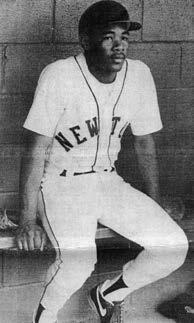

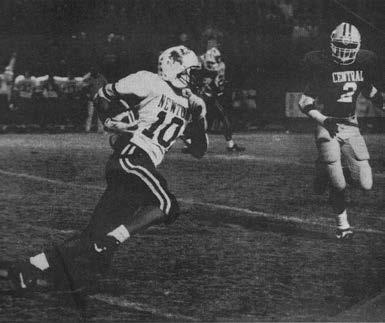
“I could’ve given up on life then, but when I found out I was going to live, I remembered the story of the Little Engine That Could,” he said. “At first, the Engine doubted himself, but once he built some momentum, he switched to ‘I think I can,’ which changed to ‘I know I can.’ I transitioned all the training, sweat, consistency, dedication and discipline to my recovery.”
Once again, Tuggle pushed himself to be the best—even when he did not feel up to it. When he finally left the hospital two and a half months later, the staff applauded him for recovering from an injury most people would not have survived. Even though the bullet injured the part of the brain responsible for speech, his voice and communication are completely clear today.
Tuggle went on to enjoy a 30-year career in logistics operations. He currently works for a tech company. Tuggle had a son, Adrian, who tragically died in an auto accident in 2013, 10 days before his 24th birthday. “That was another catastrophic event,” he said. “I only survived that through the grace of God.” Tuggle remains determined to use the trials of his life as building blocks for a better future. His shooter was never prosecuted because law enforcement ruled the incident an accident.
“This guy never even apologized,” he said. “I have forgiven him, but I haven’t forgotten. That’s my character. If you can’t forgive, you can’t move on. Sometimes in life, we feel that it’s over, but it’s not. You have to tell your brain no, this is not the end, and develop that resilience to keep pushing. Keep going, and the end will be beautiful.”
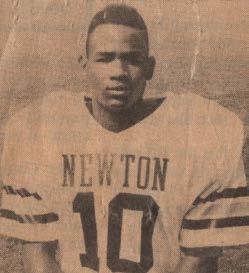

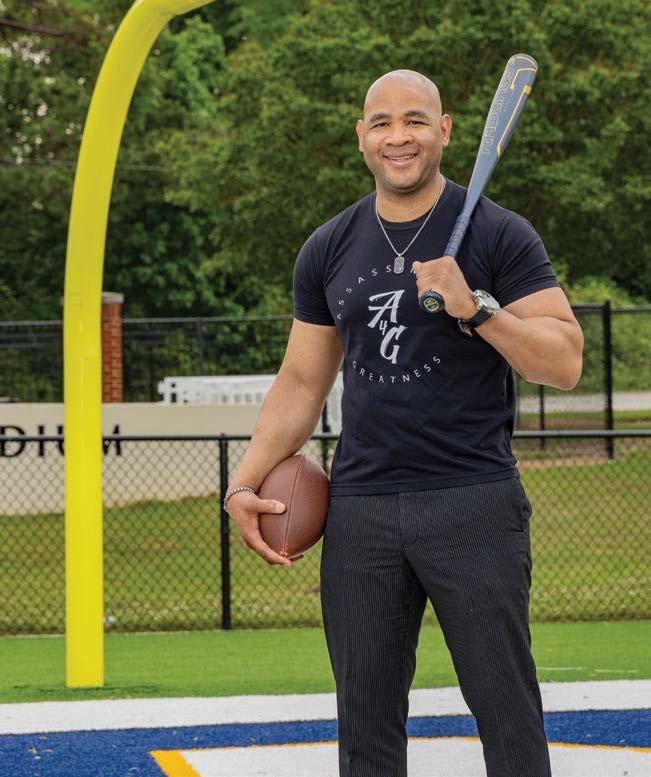
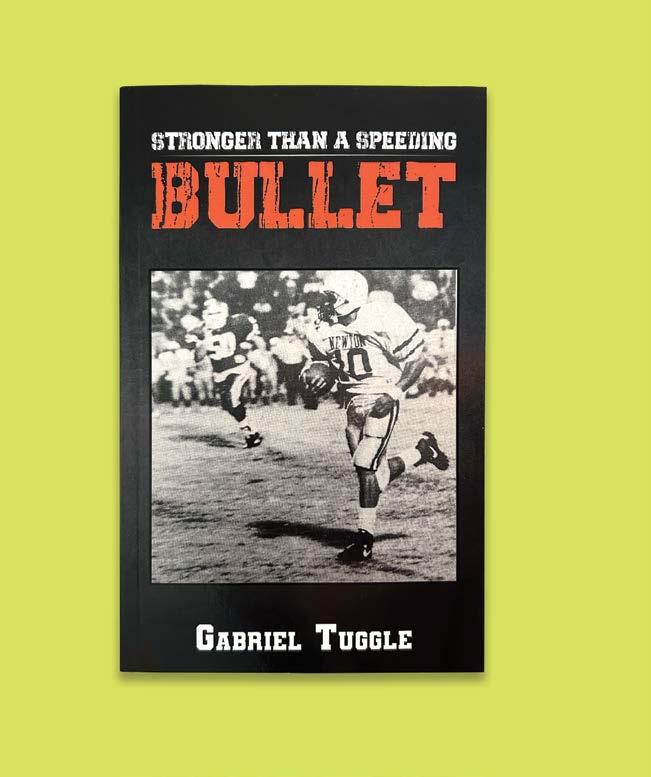
by KARI APTED

Gabriel Tuggle was a few months shy of graduating from Newton High School in 1991 when he was shot in the head at point-blank range. On track to becoming a professional athlete, his near-fatal injury brought those plans to a screeching halt. Recovery was full of challenges that could have dulled his drive for excellence. Instead, the trials only drove him to work harder and uncover God’s true purpose for his life.
“Once you find your purpose, you’re powerful,” Tuggle said. “I thought my purpose was to be a pro athlete, but now I know it is to inspire people, speak life into people, let them know that their current circumstance is not the end. I was not about to leave my life’s story in a doctor’s hands. My testimony is wrapped in a miracle, and I’m that miracle.”
Tuggle believes he repeatedly felt a nudge from God to write a book, especially during church. In 2022, he answered the call to put pen to paper. “It starts,” he said, “with my favorite scripture, Jeremiah 1:5, which says, ‘Before I formed you in the womb, I knew you, before you were born,
I set you apart for a purpose.’” Tuggle’s 144-page work, “Stronger Than a Speeding Bullet,” can be purchased on Amazon. It details his life experiences while encouraging readers to find their strengths within. Tuggle also transitioned to public speaking, sharing his inspirational story with sports teams, corporations, schools and various events. One memorable speaking gig earned him hugs and tears from a young softball player.
“She had suffered a serious injury that took her out of softball,” Tuggle said. “She said my talk really resonated with her, and it gave her hope that she could still do great things.”
Tuggle finds some of his greatest frustrations in how easily people give up on life or themselves.
“People just throw in the towel because they’re soft. People are not hungry enough these days,” he said, adding that people too often cave into discouragement instead of fighting back. He encourages others to transform or renew their mind from a negative to a positive approach. “When troubles come, that’s your test. You have to face those struggles in life. Can you stay
committed to the process while honoring your calling and purpose?”
Tuggle’s motivational speeches are peppered with lists beginning with the same letter to help his audience remember core concepts. He often mentions the Three Cs of Life—Choice, Chance and Change—and his version of the Four Rs: Restart, Reset, Redirect and Refocus. Tuggle’s life has been a lesson in all of them, and he somehow manages to condense his complicated circumstances into bullet lists of singular words. He has crafted a personal communication style that has helped hundreds of people find the strength to follow his example of turning from victim to victor. Perhaps his favorite acronym is GPS: God’s Positioning System.
“You’ve got to follow that GPS,” he said. “He puts us where He wants us when He wants to. I say that I was able to get up because Jesus got up after they crucified Him. Jesus’ resurrection is the ultimate comeback story.”
For information on Gabriel Tuggle or to book him for a speaking engagement, visit alive4greatness.com.







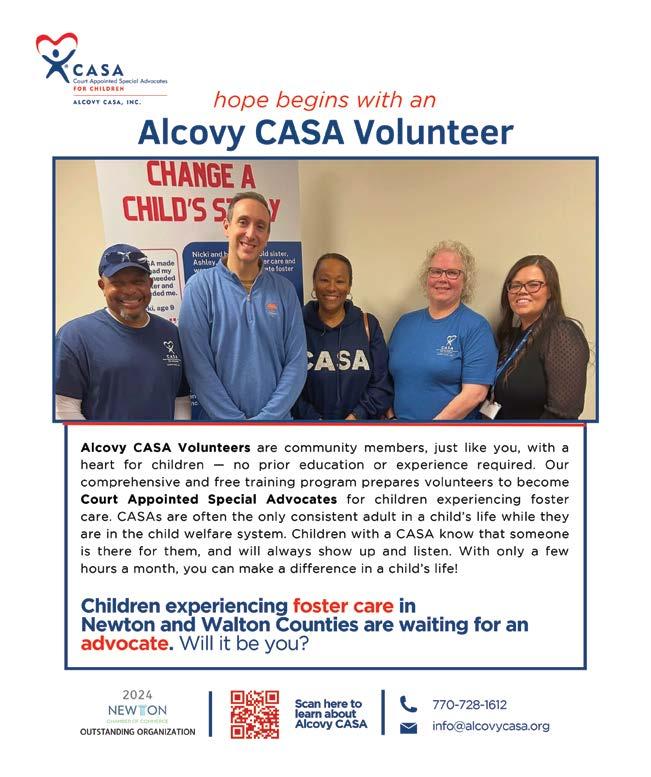
Businesses Highlights

Charmed by Covington’s quaint allure, Dr. Caroline Ceneviz took over a well-respected orthodontic practice in wake of Dr. Donald Hillman’s retirement. She integrates state-of-the-art technology with a warm, family-focused approach.
by MICHELLE FLOYD
Although Dr. Caroline Ceneviz has traveled all over the world, she has fallen so in love with Covington that she decided to take over a well-respected orthodontic practice in the city. When Dr. Donald Hillman retired from his longtime Mill Street orthodontist office in 2024, Ceneviz bought the Covington Orthodontics practice as an extension of Chamblee Orthodontics.
“He found me when he was retiring because I worked in Conyers previously,” Ceneviz said. “The town is so cute and quaint, and I love that it has the movie [industry] and history behind it. I ended up in Georgia in 2013 for a job, and I just loved it. I have developed a great community of people, and Georgia just felt like home. I’ve developed so many good connections. The weather is amazing, too, and I love that it has a little bit of everything. I love the mountains, and the beach is close, too.”
Covington’s small-town feel and the close-knit families for which the area has long been known appealed to Ceneviz. Most of Hillman’s original staff stayed on board after his departure, providing her with a bridge to existing clients.
“They helped me with patients and families. I couldn’t do it without them,” said Ceneviz, who stays busy away from the office by working on her private pilot’s license. “Everyone has been super welcoming. That’s how we run our practice. We know our families, and we really build connections.”
Heather McCullough’s daughter, Aubree, started seeing Hillman in 2024, so they were surprised to have to start with another doctor so soon. Cenviz calmed whatever fears they may have had.
“We decided to stay,” McCullough said. “We thought the transition was smooth and easy. She picked up like it was nothing, just streamlined. Aubree loves her. She thinks she’s really nice. She was really thrilled with her and happy to be there.”
Ceneviz—or “Dr. C,” as many of her patients call her—has updated the office and aims to maintain a welcoming environment, much like the one she experienced as a child.
“I was 13 when I decided to be a dentist. I loved going to the dentist when growing up,” she said. “She was sweet and kind and really into preventative issues, so I really wanted to be doing that for other people, too.”
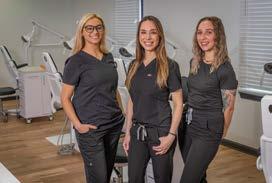
“Orthodontics lets you rehabilitate, and I love the transformation.”
Dr. Caroline Ceneviz (L-R) LINDSEY FRY, CAROLINE CENEVIZ AND KRISTIN MOORE

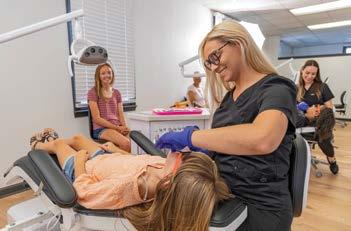
Ceneviz’s family traveled due to her father’s work. She studied dentistry in Brazil but had to attend dental school again in the United States, settling on Tufts University School of Dental Medicine in Boston and NOVA Southeastern University College of Dental Medicine in Fort Lauderdale, Florida. Ceneviz decided to focus on orthodontics because she was interested in assisting people in pain. She has authored and co-authored several publications and research projects in the field of temporomandibular disorder/temporomandibular joint dysfunction and orofacial pain.
“Orthodontics lets you rehabilitate, and I love the transformation,” said Ceneviz, a certified Invisalign Specialist. She was also a recipient of the prestigious Staley Kessel Biomechanics Award and earned the Scholarship Award from the American Headache Society. Ceneviz has introduced more technology to


the Covington orthodontic office, with services like 3D scans, Invisalign and custom-made 3D brackets.
“As we grow our practice, I like to be as cutting-edge in our field as we can,” said Ceneviz, who earned a Certificate and Master of Science in Orthodontics and Dentofacial Orthopedics from NOVA. “We’re very forward-thinking and digital. We want to be effective in what we do, so everything is faster and more precise.”
Located at 4136 Mill Street in Covington, Covington Orthodontics continues to accept new patients, from preteens to adults. For information, visit chamblee-orthodontics. com/covington.





Stories by Kari Apted
Piedmont Newton held fundraisers in 2024 to upgrade its neonatal intensive care unit. Ryan and Jalissa Kori were among the first to experience the benefits with premature daughter Khamille.
by KARI APTED

After a normal pregnancy and delivery with their first child, Kolton, Ryan and Jalissa Kori expected a similar experience with their second baby. However, just as every child is different, so too is every pregnancy and delivery. Jalissa began having contractions 11 weeks before her May 25 due date. Doctors hoped to delay the birth until she was 36 weeks along, so they admitted her to Piedmont Newton for the remainder of her pregnancy. After only a week of fighting preterm labor, it was evident that Khamille was not able to wait.
“‘NICU’ was a big, scary acronym,” Jalissa said. “You don’t expect to have the baby that early.” The neonatal team welcomed questions and quickly addressed the Koris’ fears. “The Piedmont Newton staff was phenomenal, start to finish. As a mom going through it for the first time, the initial NICU consultation days before delivery put us at ease. We were able to put faces with what was about to happen. They gave us the rundown of what to expect at each stage, giving us the best expectations for each situation but also preparing us for the worst.”
According to a 2024 Piedmont news release, having a Level 3 NICU in Newton County makes a difficult time easier for new parents by providing critical care closer to home. Previously, parents delivering at Newton would have to travel to Atlanta for premature infants to receive advanced care.
“This change in designation shows that the facility and staff are equipped to care for newborns who need one of the highest levels of medical care and intervention,” the release said.
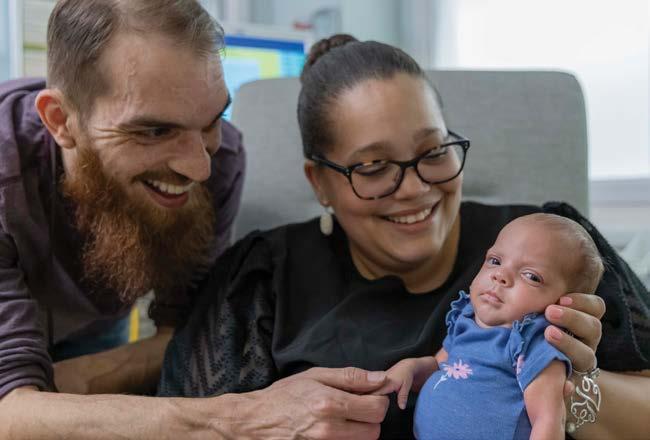
“This care might include advanced life support, a full range of respiratory support and advanced imaging. Level 3 NICU care is typically needed by babies born before 32 weeks of pregnancy.”
Khamille Rose entered the world 10 weeks early on March 16, weighing three pounds, 1.2 ounces. She measured just 15 inches long.
“At the time, she was the smallest baby in the NICU. Her hand looked so tiny compared to my pinkie finger,” Jalissa said. The NICU staff had prepared the Koris, so they knew they would not be able to hold their daughter for at least her first week of life. “They explained to us that once she was out, the doctor would hold her up so we could see her face, and then they would immediately take her to stabilize her breathing. It hurt to hear that. You never want to have that experience, but we knew what to expect at the delivery.”
The staff also prepared them for the first week of life in the NICU.
“They told us they had to keep her on low stimulus to avoid brain bleeds,” Jalissa said. “The nurses keep the babies flat on their backs and only touch them every three hours for diaper changes and temperature checks.” The Koris were coached on
how to touch Khamille when they were finally able to put their hands into her isolette. Though they were tempted to stroke their baby’s cheeks gently, they learned that light touch would startle her. “The nurses said that preemies like firm touch because it helps them feel safe or confined, like in the womb,” Jalissa said, “so we put gentle pressure on her feet and the top of her head. It was good to know that before touching her.”
After the first week, the Koris were allowed to change Khamille’s diapers and take her temperature.
“I was terrified by how tiny she was the first time I changed her, and then holding her?” Jalissa said. “She was so little.” The staff encouraged the Koris to spend as much time as possible at the NICU, promoting bonding through feedings and skin-toskin contact. Jalissa settled into a routine of dropping 6-yearold Kolton off at school and then staying with Khamille from 7:30 a.m. to 4:00 p.m. “The nurses were very accessible,” she said. “They welcomed us to call or text the charge nurse’s cell phone for updates anytime. The NICU manager checked on me every day and asked if I was resting and if I had snacks. If they had to explain when a monitor went off, they did it reassuringly, like, ‘Oh, she’s fine. Her oxygen just dropped a little.’ They did

everything they could to make it not so scary for us. You could tell they were happy to be at work, and they loved what they did.”
The six-plus weeks in the NICU were an emotional time for Ryan and Jalissa, as they had to spread their time between their two children at two locations.
“The experience shows you a new strength, a side of yourself you didn’t know you had. All I could do was pray and be present when they needed me the most,” Jalissa said. “I can’t imagine if I had to drive an hour each way to be with my baby. You never want to need the NICU, but for us, it was the best situation it could have been.” Such words are music to the ears of Lisa Rowe, clinical manager of the NICU at Piedmont Newton. “We are so glad we could offer the care this baby needed close to home for her family,” Rowe said. “When she had to stay behind in the NICU, her parents were able to visit frequently, even with an older sibling back at home. That’s the positive difference of having Level 3 neonatal intensive care right here in our community.”
After 44 days in the NICU, Khamille was big enough to go home. That was also an emotional time for Jalissa, as the staff had become like family to her.
“They asked me what they were going to do without her being there anymore,” she said. However, Khamille needed to meet another important person in her life: big brother Kolton. Jalissa admitted that Kolton having to wait so long was one of the most challenging aspects of the NICU experience. “No one under age 18 is allowed in the NICU,” she said. “We would FaceTime, and I showed him pictures, but he couldn’t wait to meet her.”
The Koris brought Khamille home on a Monday.
“We didn’t tell Kolton. We wanted it to be a genuine surprise,” Jalissa said. “My in-laws brought him home from school, and the look on his face when he saw her was worth everything. He immediately washed his hands so he could hold her. He still wants to hold her all the time and helps with everything. Seeing how they are together is so beautiful.”


“The experience shows you a new strength, a side of yourself you didn’t know you had.”
Jalissa Kori

“Life is a lot like jumping off a car. Many times, we get run down and need a jump start.”
Jeff Clegg
Believers need the assurance of faith, a connection through prayer and time spent in the Word in order to access the power of the Holy Spirit and effectively serve the Lord.
by JEFF CLEGG
Several months ago, I received a call from my wife that many husbands have gotten before. Her car wouldn’t start. I quickly jumped in my truck, jumper cables in hand, and headed out to rescue my stranded wife. When I arrived, I popped the hoods on my truck and her car with the idea that everything would work as it should. However, I ran into a problem with the negative cable. Her battery was so far back that I couldn’t make a good connection. After many attempts, I finally gave up.
It wasn’t until I reached out for help that I realized I wasn’t grounded. All the power was there. When grounded, the car started and all was well. Life is a lot like jumping off a car. Many times, we get run down and need a jump start. All the power is available to us, but we must be grounded in order to get what we need. Luke tells us about the power we can access in the Book of Acts. Jesus says to His disciples in Acts 1:8, “But you will receive power when the Holy Spirit comes on you, and you will be my witnesses in Jerusalem, in all Judea and Samaria, and to the end of the earth.”
Equal in nature, power and glory with God the Father and God the Son, the Holy Spirit is the third person of the Trinity and seen as God’s active presence in the world. He guides, empowers and sanctifies believers. Jesus tells His disciples to wait for the power. Then they will be able to carry out His will. In Acts 2, when the day of Pentecost arrived, the power of the Holy Spirit was revealed and the church took off. Luke describes what happened: “They devoted themselves to the apostles’ teaching, to the fellowship, to the breaking of bread, and to prayer. Every day, the Lord added to their number those who were being saved.”
As Christ followers, we have access to the power of the Holy Spirit to live in this world and effectively serve the Lord. However, we often fail to utilize it because we’re not grounded, which means the connection isn’t good. How can we make sure we’re grounded in our relationship with Jesus? I believe there are three requirements.
First, there’s the assurance of faith. Hebrews 11:1 says that faith is confidence in what we hope for and the assurance that the Lord is working, even though we can’t see it. The Hebrew word for faith is “Emunah,” which means “support.” Second, we’re connected through prayer, the believer’s direct line to God. We can have the assurance that He hears our prayers and knows our hearts. 1 John 5:14 says, “This is the confidence we have in approaching God: that is we ask anything according to His will, He hears us.” Third, we’re grounded when we spend time in the Word. It’s vital for spiritual growth, guidance and living a life that pleases Him. It’s a source of wisdom, encouraging individuals to love according to God’s will and to discern good from evil. Psalm 119:105 says, “Your word is a lamp for my feet and a light on my path.” The Word is the foundation for a healthy relationship with God.
Remember, when life tries to run us down, the power is always there. We just need the right connection and to make sure we’re properly grounded.
Jeff Clegg is the pastor of Stewart Community Church. For information, visit stewartcommunitychurch.com.
Oxford’s Margaret Bokros, 79, bikes for fitness and adventure, weaving stories from secret childhood rides to 138-mile treks. Her journeys— some of them reaching speeds of more than 50 miles per hour—reveal the natural world’s beauty and provide a refuge from daily worries.
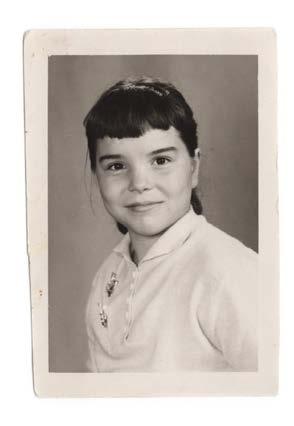
by PHILLIP B. HUBBARD
Every ride has a story. Oxford resident Margaret Bokros can chronicle countless accounts that have come from the comfort of her bicycle’s saddle. From a secret excursion at 10 years old to a 100-plus-mile day trip, she has seen and experienced much on two wheels. While others may enjoy cycling for the exercise alone, it offers a great deal more to Bokros.
“It’s the adventure and what you’re going to see,” she said. Bokros often takes the off-the-beaten-track approach to her travels. “Most people think, ‘I’m going to go to Hilton Head, [South Carolina].’ No, I don’t think that,” she said. “I’m going to go to Bluffton and maybe going down the road to Savannah, go to Garden City, go through the mansion where the murder was. That’d be kind of cool.”
Bokros was originally a runner, as she began exercising on a regular basis in her mid-20s. Roughly a decade later, she was running at Brookwood High School in Snellville, where she noticed a group of cyclers and introduced herself. Turns out it was the Gwinnett Touring Club. After purchasing a bike, Bokros jumped right in.
“I knew I could do 13 miles, but none of them were going 13 miles, except two women,” she said, “so I did that for two or three weeks, and then I started doing the 25 miles. And then you do more and more and more.”
Bokros has not slowed down since. Today, at 79 years old, she remains active in cycling while also running, hiking, kayaking and doing yard work. Some of her favorite spots include Chickamauga in Gainesville, the general Jersey, Rutledge and Madison area and Lake Varner, where she hit speeds of approximately 46 miles per hour. “I like speed a lot,” she said. In fact, Bokros has cycled as fast as 51.9 miles per hour on a trip in North Carolina.






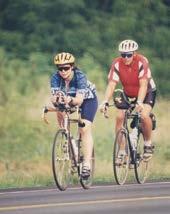


“It’s not something that you have to do. You just want to go experience whatever you want to experience that day.”
Margaret Bokros

One of Bokros’s fondest memories happened at Berry College in Rome. Her daughter was attending orientation and needed the car to drive home. Bokros took her bike for the return trip to Duluth. It was roughly an 80-mile jaunt. “You come around on that road, and you’re at the highest part,” she said. “You look down at Lake Altoona. It’s just all right there—it’s beautiful—and so, I had to stop and I had to look. And then you take a breath for a moment, and then you go on.” It was not the longest expedition undertaken by Bokros. She has biked as far as 138 miles in a single day. Among Bokros’ earliest memories on a bicycle: a confidential trip when she was just 10 years old. She grew up in Atlanta and would occasionally get on her bike and ride to Decatur—a journey to which Bokros’ mother was never privy.
“My mother never knew it, because that would have been taboo,” Bokros said. “She would ask me, ‘Well, where you been?’ ‘Oh, just down the street.’”
During her time as a cyclist, Bokros has been a part of the Gwinnett Touring Club, the Southern Bicycle League, Bike Ride Across Georgia, North Florida Tour and more. She even opened a bike store in Stone Mountain—Pedal Power—that closed 20 years ago. Earlier this year, Bokros retired from working at C Town Bikes & Fitness in Covington. As a result, Bokros has met thousands of fellow cycling enthusiasts from all areas.
Bokros currently mentors aspiring cyclists through Conyers Methodist Church’s Junior Faith Riders in Rockdale County. It has opened more doors. Bokros remembers one encounter in particular.
“Kevin, one of the kids, walked with me over at South Rockdale,” she said. “We did five miles, so I pushed him, because he was walking. He was probably really ready to quit at about three and a half, but I said, ‘Once we get to the end, you’ve got to turn around and come back. It’s not a circle, Kevin.’
When we got back, I said, ‘How you doing?’ He said, ‘Well, I’m a little sore.’”
Five decades have passed since Bokros first gave cycling a shot. She could not imagine doing anything else. During her time in retail, Bokros advised customers that all the worries of the world would fade away as soon as she left her driveway all the way to the destination. She speaks from experience, as her travels helped ease the pain of once losing a 5-year-old daughter. Bokros remains an active cycler, in part, because of the stories she gets to tell from each adventure.
“It’s just part of life. It’s your life,” Bokros said. “It’s not something that you have to do. You just want to go experience whatever you want to experience that day. That’s why I don’t go to the same place all the time. I venture out, whether I’m by myself or with somebody else. It doesn’t matter to me. I just go do it.”
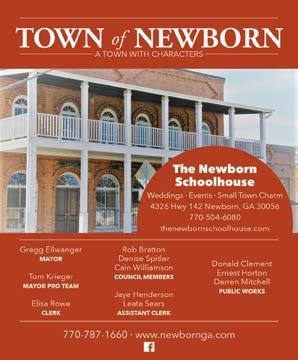
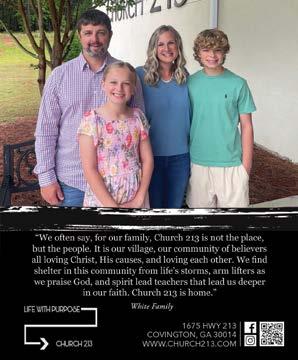


Dr. Richard Kim brings advanced care to Newton Drive Family Dentistry, where he blends cutting-edge technology with compassionate service to continue the legacy built by Dr. Dale Evans.
by MICHELLE FLOYD
Born in Korea and having grown up in New Zealand, Dr. Richard Kim decided to bring a cutting-edge dental practice to Georgia. He arrived in 2017 and joined Dr. Dale Evans at Newton Drive Family Dentistry in the fall of 2019.
“It’s an honor for me to continue his legacy of providing exceptional, compassionate, comfortable and high-quality dental care to such an amazing community,” Kim said, highlighting a practice that has been part of the Covington healthcare landscape since 1974.
The office underwent recent renovations to incorporate the latest state-of-the-art dental equipment and modern interior design with the same friendly and skillful team members that offer more than 80 years of combined experience. The practice features advanced technology, including a CBCT, ozone generator, same-day crowns, 3D intraoral scans, no-pain lasers and anesthesia, along with clean air and water filtration systems. Other services offered at Newton Drive Family Dentistry include saliva testing, oral cancer screenings, AI X-ray analysis, cosmetic dentistry options such as Botox and Invisalign, holistic dentistry and implants. The practice offers same-day services on a variety of issues and comfort options to calm anxiety.
“Our mission is to provide outstanding care to patients who expect the very best and to educate them to become partners in their own dental health,” said Kim, who was invited to the practice after being introduced to Evans at a dental society meeting.
Kim graduated from the Columbia University College of Dental Medicine in New York in 2010, followed by a General Practice Residency at The Brooklyn Hospital Center in 2011. He also served as an oral health examiner for the United States Army Reserve in Massachusetts.
“I love practicing preventive and evidence-based dentistry and establishing relationships with patients to assist maintaining their oral health,” said Kim, a fellow of the Academy of General Dentistry and the International Congress of Oral Implantologists who has also completed more than 3,000 continuing dental education hours. With the goal of developing solutions for improving oral health at the community level, he finished a Master of Public Health under the Health Care Management Track at Harvard School of Public Health in 2016.
“My passion for dentistry stems from dental humanitarian mission trips my father would take me on as a young boy,” Kim said. “I was heartbroken to observe disparities and needs in access to healthcare, especially in oral health.”
Kim added that he and Evans share the same dental philosophy to let no one come in without leaving happier and healthier.
“It’s now a lifelong goal to carry on his fine tradition of warm, professional and personalized patient-centered care,” said Kim, who enjoys traveling and spending time with his wife and son. “Our ongoing mission is to put the patients and their dental needs first.”
Covington’s Jodi Atkins, a patient at the practice for some 20 years, admits she was initially nervous when Evans handed the reins to Kim. Any concerns were soon eased.
“Dr. Kim made the transition completely seamless,” Atkins said. “He’s incredibly kind and gentle, and I always feel informed and comfortable during every visit. It’s reassuring to know I’m still in such good hands.”
Newton Drive Family Dentistry is located at 2104 Newton Drive Northeast in Covington, near the Covington Family YMCA. For more information, visit newtondrivedentistry.com.





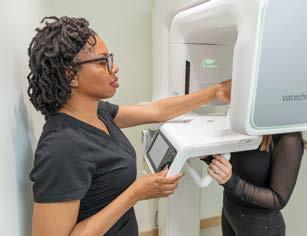
“Our ongoing mission is to put the patients and their dental needs first.”
Dr. Richard Kim









“He was such a wonderful brother. I just miss him and can’t believe he’s gone.”
Dana Hammonds
Dana Hammonds lost her younger brother and former major league pitcher David Elder to suicide in January 2023. While his legacy lives on in those he loved, coached and mentored, the sting of his absence still burns two-plus years after his tragic death.
by BRIAN KNAPP
He was the second of three children born to Butch and Debbie Elder, and from the moment he entered the world on Sept. 23, 1975 to the day he left it on Jan. 31, 2023, he kept everyone on their toes. David Elder was one of a kind, no matter the pursuit. All who were fortunate enough to cross his path were never the same again, and for those closest to him, the impact resonates much deeper.
Dana Hammonds, a nurse at Dr. Lisa D. Miller Pediatrics in Covington, had the privilege of being Elder’s older sister for all 47 years, four months and nine days of his life. She saw the story in its entirety.
“He was good at everything he did,” Hammonds said. “Always on All-A honor roll. So smart. He always had a lot of friends and was so busy. He never sat still. He was a mischievous child, and that never changed. He was driven even as a kid, and he wanted to always win and be the best.”
Elder excelled in various sports but found his true passion in baseball. While Hammonds stayed behind to attend nursing school, Butch moved the rest of the family to Pensacola, Florida, in 1990. There, Elder thrived at Booker T. Washington High School. He was a power-hitting, howitzer-armed third baseman but shined more brightly as a pitcher, throwing four no-hitters during his prep career. Those exploits earned him a scholarship to Georgia Tech, where he returned to the Atlanta area with his hometown Yellow Jackets. Elder stood out as both a starter and
a reliever, often brought to the mound by AC/DC’s “Thunderstruck” as frenzied fans replaced the Australian rock band’s chants of “Thunder!” with those of “Elder!” at Russ Chandler Stadium. Imagine the goosebumps.
A Second Team All-Atlantic Coast Conference selection as a junior, Elder was chosen by the Texas Rangers in the fourth round of the 1997 Major League Baseball First-Year Player Draft. He spent parts of five seasons in the Texas farm system— he missed the entire 1998 campaign due to Tommy John surgery—before Cleveland acquired him in a December 2001 trade for former Atlanta Braves closer John Rocker. Elder made his MLB debut with the Indians in 2002 and struck out the first batter he faced: former American League MVP Jason Giambi. He continued to pitch well out of the bullpen for Cleveland, as he compiled a 3.13 earned run average in 23 innings of relief. Elder racked up 23 strikeouts and held opposing hitters to a .220 batting average.
“It was so surreal,” Hammonds said. “I was so proud of him. We all were. He’d made his childhood dream come true.”
Injuries and ineffectiveness plagued Elder throughout 2003, the year he also became a footnote to history by surrendering the 500th home run of Rafael Palmeiro’s career in a May 11 outing against Texas. “That was the longest 20 minutes of my life,” he once told me with a self-deprecating smile, remembering his wait on the mound while the Rangers celebrated Palmeiro’s feat.


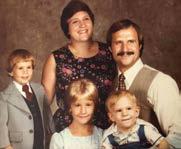
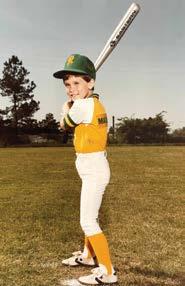
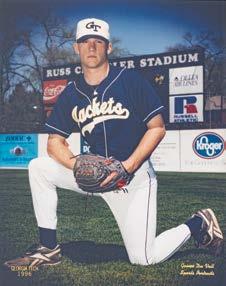
Elder went under the knife for a torn labrum in his shoulder soon after, and Cleveland released him at the end of the season. While he bounced from organization to organization in an effort to keep his dream alive, he never again returned to the major leagues. Elder retired in 2007 at age 31.
“The arm injuries were hard on him,” Hammonds said. “It was always a worry that he wouldn’t be able to pitch again, but he would work so hard to make it back. He handled it better than I thought, but he still struggled with how life was going to change. I know he missed it. It’s so crazy to say, but he seemed larger than life, like he wasn’t meant to live an ordinary life. He was meant for something more.”
Elder inevitably turned elsewhere to scratch the baseball itch once his playing career concluded, and he settled in as a coach and instructor with WOW Factor Southeast—formerly Bullpen—in McDonough. There, he established his own


gravitational pull, passing on his knowledge and wisdom to the next generation. It was where I met Elder in the fall of 2020, as he undertook instructing my two sons. He became a friend, mentor and confidant, and weekly trips to his facility soon involved our entire family. Baseball was at the epicenter of it all, but they discussed everything from girls and grades to movies, television shows and the importance of always respecting their mother. Elder had lost his beloved Debbie to cancer years prior.
“He absolutely loved coaching and giving lessons,” Hammonds said. “I think he felt like he was making a difference in each kid. He was personally vested in them. He liked being busy and he loved people, and he always wanted to help kids and be someone that people looked up to.”
Though none of us knew it at the time, my boys had what would be their final lesson with him on MLK Day in 2023.
“Y’all be careful,” Elder said as we left. He disappeared behind
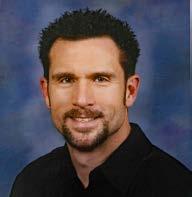

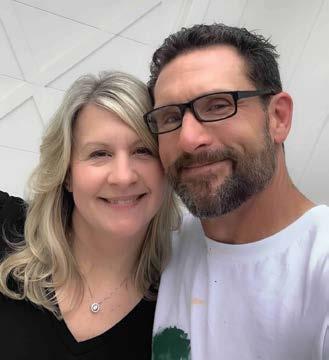
the door as it shut behind us. A little more than two weeks later, the devastating news reached us: David Matthew Elder was gone. Hammonds was at work when she heard.
“My dad was coming by to pick up something from me, so I had told him to come up front to the main entrance,” she said. “He messaged me and said he was around back and to just come down there. As I approached, he rolled his window down, told me he needed to talk to me and to come sit in his truck. Little did I know that my life was about to be completely turned upside down. I honestly thought my dad was going to tell me he had cancer or something like that, but he looked at me and said, ‘Dana, your brother David took his life this morning.’
“My heart stopped beating,” Hammonds added. “My dad broke down crying, and I lost it. I started hyperventilating, and I jumped out of the truck. I couldn’t breathe. My baby brother? Dead? No, it couldn’t be. I needed to talk to him. I was completely heartbroken and shattered.”
A standing-room-only crowd attended Elder’s funeral at Crossroads United Methodist Church in Conyers. Tributes poured in amid laughter and tears. Left behind were countless friends, former players and adoring family members, most notably his 9-year-old daughter. “She was the light of his life,” Hammonds said. Warning signs were few, and none raised
the alarm that he had turned down a dark path in the final months of his life. Caution and wisdom were born out of tragedy.
“Be there to be present for your loved ones that you know are struggling,” Hammonds said. “Don’t ever assume that they’ll come to you if they need help. They may be too embarrassed, or they may not want to bother you. I wish I would have been more involved with him, talked to him more, pressed him more. I would ask if he was OK or if he needed anything, and he would always say he was good. We were very close. He was such a wonderful brother. I just miss him and can’t believe he’s gone.”
Hammonds did not have to search far for comfort.
“He was a Christian and had a strong faith in God,” she said. “Knowing we’ll see him again one day gets us through our grief.” Elder would have turned 50 in September, which happens to coincide with National Suicide Prevention Month. Hammonds admits that knowing her late brother’s legacy will live on in those he coached provides some peace in his absence, though the void that remains can never be filled.
“When we had to clean out his apartment, I found a piece of paper with something my mom had written,” she said. “It was near him when he died. It said, ‘To live in the heart of those you leave behind means you live forever.’”
Stories by Phillip B. Hubbard

Kaitlyn Williams will take her considerable talents to Savannah State University after a decorated four-year career with the Alcovy High School fastpitch softball team. If past history serves as any indication, her impacts figure to extend far beyond the field.
by PHILLIP B. HUBBARD
The five-tool player designation fits Kaitlyn Williams. Whether in the batter’s box, on the bases or in the field, opponents see her as a force to be reckoned with. She compiled quite a career resume in four seasons with the Alcovy High School fastpitch softball team, which resulted in multiple scholarship offers.
Qualities that keyed Williams’ multifaceted success on the diamond also translate to other aspects of her life. She serves in the youth group at Solid Rock Church in Social Circle and works as a sales associate at Worthy Clothing Co. on The Square in downtown Covington. No matter the arena, Williams brings one constant with her: a smile. Consider it a byproduct of what she was taught at a young age.
“Growing up, my parents instilled in me [that] ‘a smile can change somebody’s day,’ and that’s something I carried heavily with me,” she said. “Then also getting stronger in my faith just as I got older. My favorite quote ever is to say, ‘But God.’ Whatever happens, you still have God, so that’s one of the
things that keeps me positive. Everything’s going to be OK and, at the end of the day, the day is going to end and you’re going to get a fresh start tomorrow. You’re always going to be able to start, hopefully, with a clean slate.”
Williams began her softball journey when she first picked up a bat at 3 years old. Her father, Dr. Kristopher Williams, played college baseball and passed along his passion for the game. Williams blossomed into a multi-dimensional player and gained experience at every position except pitcher and catcher. In addition to the time she spent with Alcovy, she has been part of various travel teams, from Georgia Mayhem and Lady Jackets to Georgia Bombers and Elite Diamonds. During 112 career games at Alcovy, Williams registered a .417 batting average with 83 runs batted in and 48 stolen bases. She committed only 14 errors in her four years at the varsity level, good for a .954 fielding percentage. Williams led the Lady Tigers to consecutive region championships as a sophomore and


“I always believe what goes around comes around, and that’s something that’s super big to me.”
Kaitlyn Williams


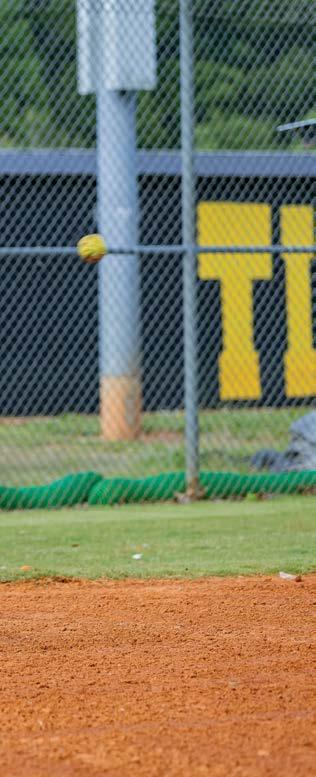
junior, along with the first Elite Eight appearance in school history. She racked up plenty of individual accolades, too.
Williams was named to the First Team All-Region twice and Second Team All-Region once, while also winning Alcovy’s prestigious Gold Glove award in 2023. She was named the team’s Most Valuable Player as a senior.
William’s love for softball runs deep for a variety of reasons.
“It’s a failure sport,” she said. “You’re going to fail more times than you succeed, so, if anything, it taught me how to face adversity. That’s one thing I did enjoy about playing. It did teach me to face adversity, and it did show me you’re going to fail in life but you’ve got to pick yourself right back up.”
Williams also excelled in the classroom, where she ranked in the Top 10 of her graduating class at Alcovy. A member of the National Honors Society, she simultaneously took Advanced Placement and Dual Enrollment courses. It all paid off in February, when Williams signed her national letter of intent to play softball at Savannah State University, where she intends to major in biology. She enrolls at the school in the fall to pursue a long-term goal of becoming a doctor while serving as a utility player with her new team.
Church remains a focus for Williams. She attends Sunday and Wednesday services, assists with special events and participates in Pursuit, the student-led ministry at Solid Rock.
“Caring [is my calling] … [and] listening to people, whether we do small groups and they’re going through something,” Williams said. “I think I do very well. I’ve been told that I do very well just talking to people through situations and offering my advice on how I would handle a situation or how you should according to the Bible.”
Williams also throws herself into the job at Worthy Clothing Co., just one of the many hats she wears. Among her responsibilities: sales, setting out items on the floor for display, creating barcodes and steaming clothes.
“I always say, ‘You never know what these women are coming here shopping for,’” she said. “They might have just had a baby and they’re like, ‘Well, I don’t really know what to look for? I’m just trying to get my style back.’ You’re able to help them out. Or they’re just going through a tough time and you’re able to talk to them and help them out and spread the Gospel. That’s our thing in there: ‘Flawed and still worthy.’”
To fulfill her daily itinerary, Williams stays in rhythm with her routine. From going to the gym at 7 a.m. to being asleep by 11 p.m., she has everything mapped out. However, she does not do anything begrudgingly. Quite the opposite seems true. Every ounce of effort—playing the sport she loves, serving her home church or assisting customers—goes toward shining a light for others.
“I want people to see Jesus through me. I want to give back,” Williams said. “I always believe what goes around comes around, and that’s something that’s super big to me.”











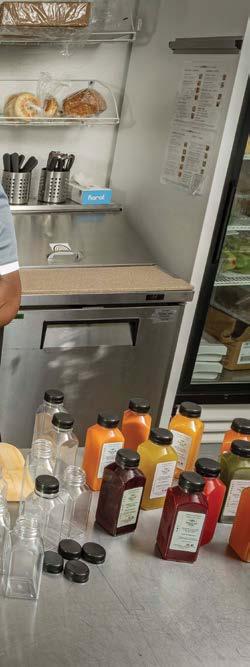

Stories by Michelle Floyd
Father-son duo Rutho and Nate OccilienSimilien have transformed a 21-day juicing fast into a thriving business. Taste & See Fresh has grown by leaps and bounds in a few short years, with additional expansion still to come.
by MICHELLE FLOYD
Healthy habits turned into a business venture for one entrepreneurial-minded fatherson duo. A few years ago, Covington resident Rutho Occilien-Similien started juicing during a 21-day fast while working as a technology specialist for the Newton County School System. It changed his life.
“I noticed benefits right away. It was a great experience,” said Rutho, who moved to the area from Miami in 2007. “I lost a lot of weight. My energy level went up. It was an amazing feeling. My body felt the difference immediately with the cleanse that was freeing toxins out of it.” Others noticed, too. “People asked me if I did meal prep,” he said, pointing out that his job allows him to meet and see a lot of different employees around the county. Soon, he started bringing in various juices and meals for coworkers. “It was only supposed to be for a few people,” Rutho said, “but word got around the schools, and it grew into something.”
His son, Nate, took note after attending Disney Dreamers Academy in 2022 and decided to assist his father with the fledgling business. “The rest is history,” Nate said. A rising sophomore studying business administration and philosophy at Oxford College, he helped Rutho build a business plan for Taste & See Fresh, as they created a form through which customers could order for delivery.
“I don’t mind doing this with my son,” Rutho said. “I thought this would be a good opportunity to work with him. I want to be able to leave a legacy behind— and for his children, too.”

“I love the taste and variety.”
Jason Stonek

Eventually, they connected with the Covington Farmers Market, where they set up a tent, table and offered a variety of coldpressed juices.
“We went there, and we sold out the first time,” said Nate, who graduated from Peachtree Academy in 2024. “At that point, we thought we might have something special.”
Currently, they offer 10 juices on their menu. You generally can find them at the Covington Farmers Market and occasionally at the Oxford Farmers Market.
“I was at the Covington Farmers Market and saw them, and now I’m hooked,” said Covington resident Amy Thomas, who works with Rutho and once taught Nate. “I’ve tried fruit juices in the stores before and never really liked them because they are so sweet and loaded with additives and sugars, so I’m glad I get to enjoy the flavors now and know it’s healthy.”
Taste & See Fresh’s most popular choices are Tropical Storm— a blend of strawberry, oranges, pineapple, mango, spring water and agave—and Super Green, made with cucumbers, kale, celery, red apple, ginger, spring water and agave.
“We obtain produce, fruits and vegetables, from vendors and different stores around our area, then clean and prepare and cut them for our industrial juicer,” said Nate, a former intern at Lily & Sparrow who now holds down various roles at Oxford College.
“They are not pasteurized and have no extra preservatives.”
The company also offers custom juices, salads and cabbage rolls. It will deliver anywhere in the metro Atlanta area and ship nationwide.
“There’s no excuse about getting juice in your hands,” Rutho said, who enjoys providing healthier choices for the area in which he lives. Juices can be enjoyed casually or as part of a detox or juicing plan.
“I love the taste and variety,” said customer Jason Stonek, of Covington. “Initially, I stuck to safer options for fruit-and-vegetable juices because I didn’t want to try anything I thought I wouldn’t like. However, I was pleasantly surprised to discover that even fruits and vegetables I normally wouldn’t touch in the produce section were the perfect blend in the juices.”
Taste & See Fresh juice has been featured in stores like Town Square Olive Oil. The Occilien-Similiens hope to find more avenues for expansion in the future.
“It’s really all God,” Rutho said. “God is really moving with His pace. I definitely see this growing to being in retail all over, maybe even franchises and distribution into stores. Expanding is always one of those things we need to do. We can’t just stay where we are. We started out small and we’re growing, from custom juices to retail to different juices to maybe a restaurant. I don’t know. The sky’s the limit.”
For information on Taste and See Fresh, visit tasteandseefresh.com, along with the company’s pages on various social media platforms. The Covington Farmers Market opens most Saturdays in May through August— weather permitting—from 9 a.m. to 1 p.m. at Heirloom Park near the Covington Welcome Center.

“Now that I’ve let go, I’m just pumping stuff out.”
Tray Corley
Tray Corley never attended art school, but his paintings are already intriguing enough to have drawn fans from across the globe. His once-latent creativity has exploded into a personal passion that drives him to spend nearly every waking hour churning out new works.
by KARI APTED
Tray Corley can explain his motive to start painting in just four words: “I needed a hobby.” The simple sentence conjures up images of a casual artist dabbling watercolor onto a square of paper, producing a basic butterfly or a humble landscape before walking away to watch TV, text a friend or find another way to occupy his time. However, painting involves so much more for an unconventional artist like Corley.
Most artists use a single room as their studio. Corley uses his entire 200-year-old house. Tall shelves line the walls, filled with thousands of paint tubes and bottles. He is not picky with his media, using everything from acrylics to oils and gouache to spray cans. It does not matter to him if paint splatters all over the hardwood floors, as he points out that they need to be redone anyway. The dried drips on the ceiling fan’s blades add character. His colorful chaos extends into the kitchen, where half the sink is filled with dishes and the other side holds palette knives and brushes waiting to be washed and reused. Had someone told Corley two years ago that this would be his life now, he would not have believed them.
“When I was in seventh grade, I guess that’s when ADHD decided to roam into my little head. I got in trouble for drawing
all over my notebooks,” Corley said. “My teacher confiscated the notebooks and scheduled a parent-teacher conference. She thought I was disturbed and needed therapy.” Corley admits that his drawings were potentially alarming, as many of them illustrated violence. “I have a dark personality,” he said. “I don’t mean you’re going to see me walking around wearing eyeliner, but I was introduced to horror movies at a young age. They fascinated me.” Having his parents, a teacher and a therapist think he was troubled turned Corley off from creating art entirely. “I knew some artists were known for that type of work, but the whole experience changed me so much,” he said. “it felt like art was just another project to please someone else, so I didn’t want to do it anymore.”
Decades passed before hard times bubbled Corley’s creativity back to the surface. Cancer, a divorce and issues with his career in facility maintenance management opened up his schedule, and he felt an overwhelming need to find an outlet for his frustrations.
“I had a range in my backyard and all I did was shoot, so I started playing music on my phone, and that’s when I learned that I can hear color,” he said. “I dove into some leftover paint and started going ham.”

Corley sees his ability to hear color as the force behind his dramatic works. This ability to cross senses is called synesthesia, and though it sounds like something from a science-fiction film, it is a real condition that affects as much as 4% of the population. Corley experiences chromesthesia, a subtype where certain sounds trigger color perception.
“That’s how I get all these crazy backgrounds,” he said. “I turn up the music loud and spend most of my time on the background. That’s when I begin to see the objects. There can be a 90-degree angle, and I turn it into a cityscape. Then I feed off that one thing, building the composition up and down.” When Corley paints, he always has another canvas behind him. He uses it to clean off his palette knives. Then those random swaths of color provide the start of another background, and the process continues. “I will end up having 17 in a line, ready for me to go. Right now, it’s in the teens, the number of projects I’m working on,” he said. “That way, I’m never stuck on one thing because I have 15 behind it. I’ve been allowed to focus on art right now. I wake up, paint, go to bed, repeat.”
Corley has created a truly astounding number of works, considering that he only started painting full-time in January 2024. He estimates that he has painted over 700 canvases in less
than two years. They are not small pieces, either. His favorite canvas is a 30-by-40-inch gallery wrap, and he has recently started framing some pieces in older, gaudy gold picture frames. He also started painting on glass and discovered that he loves it.
“Now that I’ve let go,” he said, “I’m just pumping stuff out.”
Corley’s neighbor in 2024 urged him to create an Instagram account. He named it @art_theperson and uploaded photos of his paintings, pairing each with one of the songs he listened to while painting it. He immediately began getting noticed. Two weeks later, an art curator from Spain reached out, and Corley contracted with them.
“That’s when I started getting serious,” he said. “I noticed that my style was changing, but any time I change bands or albums, my style changes. I just enjoyed letting my head and hands do everything without my brain interfering.”
His work is currently displayed at a gallery in Madrid, and he has been invited to participate in several international art shows, including Red Dot in Miami. Closer to home, he has gained the support of Southern Heartland Art Gallery, where he has several works for sale. His parents, once worried about their young son’s propensity for horror, now fully back his endeavors. Corley admits that he sometimes finds himself

toning down the dark vibes that naturally make their way into some paintings.
“I live in Covington now,” he said, “so I have to change it up a little.” However, he was quick to acknowledge the therapeutic value of his craft, specifically the non-aggressive catharsis that comes from expressing negative emotions through art rather than acting them out. “If I’m angry and I draw it, I’m getting it out of me,” Corley said. “I’m not taking it to work with me or taking it out to dinner. Look at it this way: Would you rather have someone paint a picture of knocking you upside the head or actually do it? Either way, the negativity gets out of their head.” Corley also notes with a laugh that strong negative emotions inspired some of his most colorful paintings. “Someone asked me if I was trying to say that not everything dark is evil,” he said. “I replied, ‘No, what I’m saying is that evil can be really colorful.’”
Corley points out that he has never adopted one style of painting. He lets whatever he may be going through and whatever he may be listening to at a given time flow onto the canvas.
“I literally don’t plan anything. I’ve never planned what I wanted to paint,” he said. “I don’t even know what the end result will be when I start, so every day is a surprise to me. I don’t sit down until I go to bed. It’s great.”












Stories by David Roten
Doug Doster’s faith fuels a global outreach, though the 85-year-old former grocer has worn out a path to Mexico. His tireless service transforms lives through sharing the Gospel and tending to the needs of the poor.
by DAVID ROTEN
If there was just one epithet that could be added to Doug Doster, it might well be “Man on a Mission.” Grounded in faith and marked by service, that mission has often led the 85-year-old to distant places around the globe. As a young boy, he rarely ventured far from his home in Porterdale, where he was born and raised. “Growing up,” he said, “I had no idea that I would ever go outside the United States.” However, as a young man, Doster saw horizons expand and borders disappear. “I’ve just always had a desire and a heart to help people,” he said. “The Lord opens the doors, and I stumble in.” To date, Doster has visited Cuba, India and the Philippines, but he has most often traveled to Mexico, sharing the Good News of Jesus Christ and helping to feed the poor along the way.
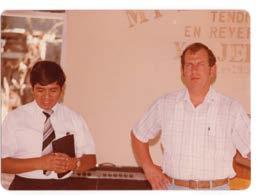
Looking back, Doster remembers growing up in church and feeling a “spark of interest” whenever a visiting missionary came to speak. The spark ignited a flame inside Doster when, in his 30s, a chance meeting at a South Georgia Methodist Conference led to an invitation to go on a mission trip to Monterey, Mexico.
“I just kind of fell in love with the people there,” Doster said, “and God began to give me opportunities to go [on other mission trips].”
For a time, the work was mostly evangelical: “going, sharing, preaching.” Then Doster heard a Mexican seminary student share a stirring story about a poor, single mother and her children. With tear-filled eyes and halting voice, Doster relived the pivotal moment. “She told how these kids would go to sleep at night with hunger pains—crying,” he said, “and well, the Lord moved on my heart to start a feeding ministry down there.” Ten days later, Doster had finalized plans for a trip to Monterey, and $10,000 was donated for the effort. Upon arriving in Mexico, Doster met a local dentist named Dina Gomez who shared his vision to assist the poor in that area. “The Lord put us together,” he said, “and we began to raise money and to build and set up feeding stations.” The small concrete-block buildings served as a place where meals could be cooked and handed out while also functioning as a place of worship on Sundays. “We did the feeding ministry for a good many years and, for whatever reason, it ran its course,” he said. One door had closed but another, born of tragedy, would soon open.
IN
WRECK), BOBBY WILBANKS, MOURAD BOWEN, JEHU SANCHEZ, MATT ALLEN (KILLED IN THE WRECK), GREGORY BOWEN AND LAURIE HUNNICUTT

On July 15, 2000, Doster and his volunteer team of five men and one woman had just wrapped up a mission trip to Delicias, Mexico, where they had helped build a house for a native pastor. As they were making their way back home in the early hours of that fateful morning, the van in which they were traveling strayed from a Texas highway into the median and flipped over. Injuries from the crash ranged from none to minor to a broken leg. Doster suffered broken ribs and a punctured lung. Two of the men did not survive. One of them, south Georgia native Dillon Smith, was a recent acquaintance of Doster. The other was 27-year-old Matt Allen, Doster’s good friend and fellow church member.
“My life was spared, but I was broke up physically, mentally, spiritually,” he said. “I thought this would be an end to the mission we were doing in Mexico.” The day of the accident and the ones that followed were difficult for Doster. “You always ask ‘Why?’” he said. “And you never really get an answer.”
Four months later, Doster was working as an independent grocer and found himself on an early morning run to Atlanta Farmers Market to pick up produce when the Lord began to slowly open another door. “I got the idea that we could do Christmas gifts, like Samaritan’s Purse, for those children down in Mexico—first of all to honor the Lord Jesus Christ and, second, in memory of Matt and Dillon,” he said. With just a few weeks remaining before Christmas, Doster set an ambitious goal of 1,000 shoeboxes, each filled with a toy, a bit of clothing, personal hygiene products, school supplies and a note, written in Spanish, with the gospel message. With the help of his church and “a few buddies” in south Georgia, the goal was reached. “We lit out for the border with a thousand gifts in the church trailer and no idea how we would get them across the border,” he said. “We ran into all kinds of roadblocks.” After two days of trying unsuccessfully to accommodate Mexican customs regulations, the decision was made to try
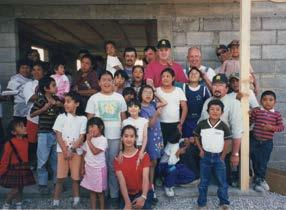
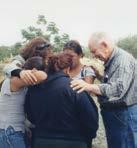
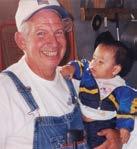
another border crossing. “I still don’t know how we got through, but somehow, grace of God, we got to Monterey and went to some of those poverty areas where the feeding stations were and delivered the gifts,” he said. Mission accomplished.
Doster and his teams have repeated the benevolent enterprise annually since 2000. The process of getting the gifts across the border and into the hands of Mexican children has improved dramatically. Utilizing contacts on both sides of the border, arrangements are made for local pastors along the south side to cross into the United States at strategic points, pick up the gifts and return to distribute them. It is a win-win for Doster and his team, as they avoid excise taxes on the gifts and minimize the likelihood of contact with increasingly dangerous cartels.
Over the years, Doster has made multiple evangelistic mission trips to Cuba, India and the Philippines. However, he has practically worn a path to Mexico, making the journey over 100 times to share the Good News and show the love of Jesus by feeding and caring for the poor. Doster is already training others to ensure the Christmas gift shoebox ministry outlives him.
“As long as the doors stay open and the help stays good, we’re going to continue to do what we’re doing,” he said. The mission is currently supported by several local churches,

including Julia A. Porter Church, Dovestone Church, Gaithers United Methodist Church and Stewart Community Church, as well as Gatewood Schools in Eatonton.
Doster shares life and love with Carole, his wife of 57 years. “She has played a huge part in my ministry through prayer and seeing after things when I was away,” he said. Doster reflected on the motivation behind all his missionary endeavors.
“My purpose in life is to grow the population of heaven and to help hurting people,” he said. “God opens the door, and sometimes, we walk through it not knowing how whatever we’ve been called to is going to get accomplished, but some way, somehow, He makes a way.”
Emblazoned on the side of the trailer that transports gifts from Doster’s ministry are these words: “OPERATION 405 SHOEBOX MINISTRY — to Mexican Children — In Memory of Matt Allen & Dillon Smith.” Shoeboxes have actually been replaced by plastic bags, as they are easier to pack. “405” references the weight Matt Allen was able to bench press as a 15-year-old fighting back from the weakening effects of chemotherapy used to treat a brain tumor.
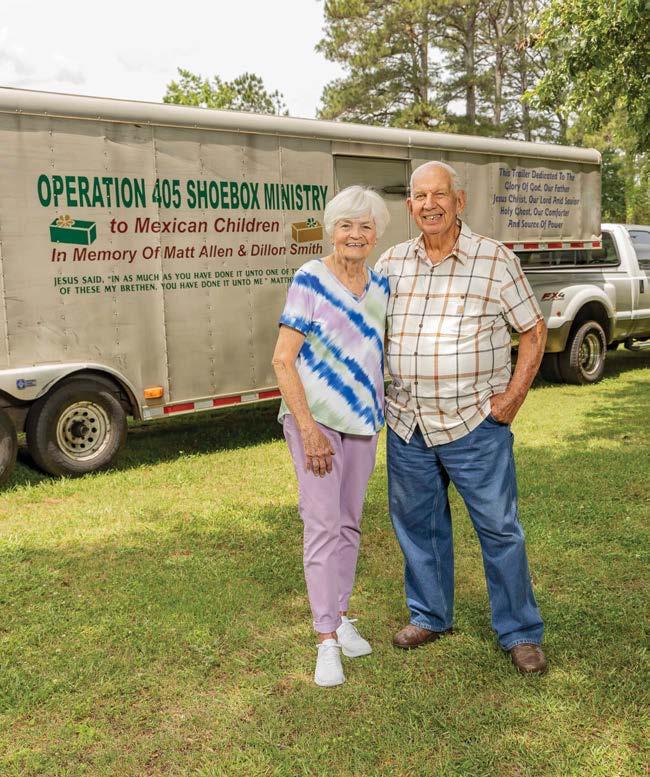
“The Lord opens the doors, and I stumble in.”
Doug Doster
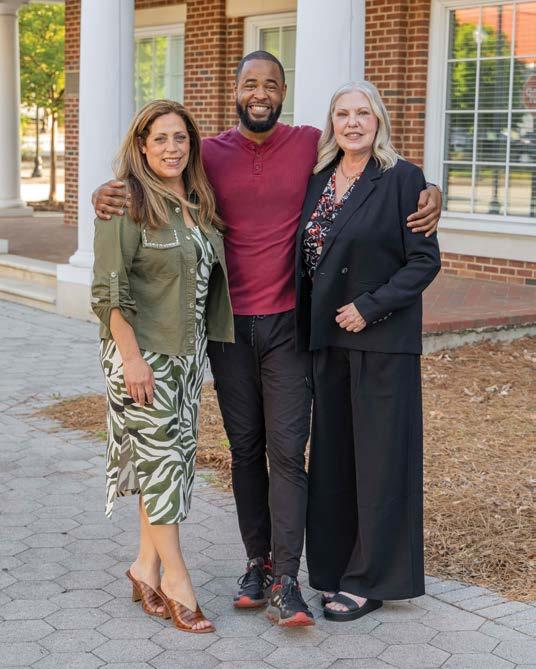
Jay Hobbs faced prison at age 25 but found redemption through Georgia’s Resource Court. Its rigorous support system transformed his life, offering him hope over punishment.
by WENDY RODRIGUEZ
Jay Hobbs never imagined he would be standing in a courtroom at 25 years of age, let alone waiting for a judge to decide his fate between freedom or a prison sentence. A 2019 graduate of Emory University, he had never encountered so much as a hint of legal trouble. However, when the COVID-19 pandemic struck, his mental health took a hit and sent his life down an unexpected and troubling path.
“I felt thrust into a situation that I didn’t belong in,” Hobbs said. “I was confused and felt like my life was spinning like a carousel. You get to a really low point, and you get so low that even though you may realize that you need help, you may not know how to pursue that help even when it’s put in front of you. You might be like, ‘I don’t need it. I feel like I can handle it.’ You know you don’t realize how far things have gone.”
In December 2021, he was sentenced to one year of incarceration and nine years of probation. However, instead of serving time in prison, Hobbs was given a second chance through his 20-month journey in Georgia’s Accountability Court Program, also known as Resource Court.
“They offered me an alternative to the kind of time I was facing. Any chance of getting out, I was like, ‘Yes,’” Hobbs said. “I got into the program. I knew it entailed a few different things. There was a 40-page handbook of rules that you had to follow, so it was pretty intimidating initially, but it’s a program that you have to want to do. You have to want change to shift
your situation. The program is great because they have the resources for you to make that change.”
Hobbs considers the program to be both demanding and transformative.
“There were a lot of stipulations and restrictions,” he said, “[but it forced me to] kind of sit still, to really reflect and not have to worry about certain aspects of life. I was kept on the straight and narrow, which I actually found really helpful.”
The structure, though rigid, offered him something he had not experienced in a long time: stability. Hobbs attributed his transformation and growth to the resources provided by the program. It allowed him to see what needed to be fixed in his life. With clear expectations and accountability built into each step, Hobbs leaned into the resources provided to him. He was not driven by fear and punishment but by a genuine desire to rebuild and transform his situation.
“The resources were there, but I didn’t know how to use them,” Hobbs said. “I didn’t know what life was supposed to look like or what it wasn’t supposed to look like. First-generation college student, no father, no real guidance. I was figuring it out on my own in college.”
The Resource Court was originally established by the Judge Samuel Ozburn, who had long witnessed the revolving door of individuals with untreated mental health conditions cycling through the criminal justice system. Determined to break the
“I was kept on the straight and narrow, which I actually found really helpful.”
Jay Hobbs

cyclical pattern, Ozburn helped launch the program that uses accountability and evidence-based treatment to rehabilitate individuals struggling with mental health and drug abuse in the community. This multidisciplinary court is specifically designed for individuals diagnosed with mental illness, providing them with structured support, treatment and accountability in lieu of incarceration. Participation is entirely voluntary. Those who choose to enroll must commit to a rigorous set of requirements, including regular treatment, supervision, curfews and even home visits and searches. In exchange, they are given the opportunity to avoid incarceration and work toward lasting recovery.
The success of the Newton and Walton County resource courts depends heavily on the work of dedicated coordinator Beth Smith, who brings a decade of experience to the program. In addition to working with participants on a day-to-day basis, she manages the grants that fund the court’s services. The largest source of funding comes from the Council of Accountability Court Judges of Georgia, with the counties contributing a required 25% match.
“Our goal is to reduce recidivism and show participants how to rebuild their lives and, in many cases, reconnect with and teach their families,” said Smith, who also ensures that the services promised to participants, such as therapy, supervision and job support, are actually delivered.
Today, the court continues under the leadership of the Judge Layla Zon. She described overseeing the Resource Court as one of the most rewarding parts of her job because she sees firsthand how the program transforms lives. It offers hope and healing instead of punishment. It was through this program that Hobbs received a formal diagnosis and began treatment with prescribed medication and therapy, marking the beginning of a new chapter in his journey. From the start, he took steps to confront the challenges that led him to court.
“He began addressing the issues through therapy and selfreflection,” Zon said. “The program provides resources that help individuals understand what brought them here in the first place. Jay was always hardworking. When he first entered the

program, he walked miles every day to get to work. Throughout the program, he kept steady employment, got a bicycle and eventually a car.
“Jay was one of the easier cases because of his pleasant demeanor,” she added. “He’s the kind of guy who stays behind to clean up after serving others. Jay is just one example of many who come in broken and defeated but leave the program with a renewed sense of purpose and success. You can restore someone back to life with the proper resources.”
Georgia is now recognized as a national leader in Accountability Courts, as its programs undergo regular peer review to ensure
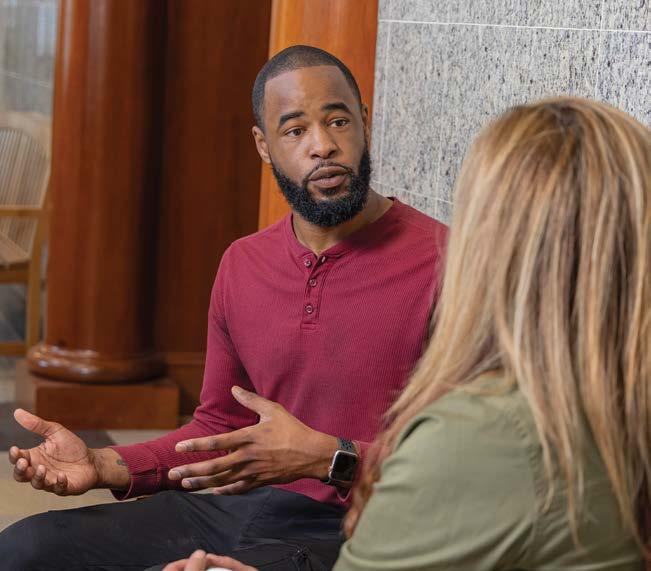
continued effectiveness. These courts continue to lead the nation in providing comprehensive care and second chances to individuals facing mental health and substance use challenges. Now 29, Hobbs frequently returns to support the program that once supported him. He serves as a mentor and example of what is possible.
“For someone like me to graduate and then come back to speak to newer participants, I think that really helps,” he said. “I try to go back to court when I can, not all the time but enough to be present and to encourage the people who are just starting. I know what it feels like to be in their shoes.”
Hobbs’ words and actions serve as testaments to how far he has come and how deeply he values the second chance he was given.
“It’s easy to say yes when you’re in jail,” he said. “You want out. You want that little bit of freedom again. You’re not in prison, so it feels like a win, but when the rubber hits the road, that’s when it gets hard. The structure, the expectations, the accountability—it’s a lot.”
For more information on the Council of Accountability Court Judges of Georgia, visit cacj.georgia.gov.

by WES KENT
As a professional chef who trained at Johnson & Wales University in Charlotte, North Carolina, I enjoy showing others how to make restaurant-quality food at home. I chose both of these recipes with summer in mind, as they utilize an outdoor grill as the heat source. There’s nothing better than lighter dishes to go with a very hot day. These selections are also simple and quick to execute, making them easy and fun for the home cook.
INGREDIENTS
SOURDOUGH TOAST WITH WHIPPED RICOTTA AND SUMMER SQUASH
• 3 oz. ricotta cheese
• 1 oz. of honey
• 1 slice of one-inch-thick sourdough bread
• Thinly shaved zucchini and yellow squash (6 slices per serving)
• Thinly shaved radish (5 slices per serving)
• Several sprigs fresh dill and fresh parsley, chopped
• 3 oz. extra-virgin olive oil
• Juice of 2 lemons
• Kosher salt, sugar and freshly ground black pepper, to taste
DIRECTIONS
Brush olive oil on both sides of sourdough bread and grill to toast both sides. Season toast with salt. Let the toast rest while preparing other ingredients. With a mandolin, shave half a summer squash and half a zucchini to ¼ inch. Sprinkle both sides of the squash with salt, sugar and lemon juice and let sit to cure for 30 minutes. Whisk ricotta, honey, and one ounce of olive oil together until
incorporated. Season with salt and pepper to taste. Spread ricotta mixture on top of toast. Roll up squash and zucchini ribbons and place on top of ricotta. Garnish with radish slices, dill and parsley. Drizzle with olive oil and lemon juice.
GRILLED CABBAGE SIDE WITH CORN, PARMESAN AND SUNFLOWER SEEDS
• 1 head of cabbage,
• 1 oz. chopped parsley cut into 6 wedges
• 2 ears of fresh corn, husked
• 1 oz. chopped cilantro
• Olive oil and charred on a grill
• 2 oz. sunflower seeds
• Lime juice
• Kosher salt and freshly
• 2 oz. grated parmesan ground pepper, to taste
• 2 oz. pomegranate seeds
DIRECTIONS
Apply a light coat of oil to all sides of the cabbage wedge and grill on each side to get good color on all sides and cook through. Arrange cabbage on a platter to cool. For topping: In a mixing bowl, add sunflower seeds, pomegranate, parsley, cilantro and charred corn cut off the cob. Season with salt, lime juice and olive oil and mix lightly with a spoon. Place the topping on the grilled cabbage and garnish with grated parmesan and a drizzle of olive oil.
For more information about culinary consultation, events and catering visit Kentish Hospitality at kentishhospitality.com.
“I enjoy showing others how to make restaurant-quality food at home.”
Wes Kent




Revisit some of your favorite stories from our past summer issues available on our website.





